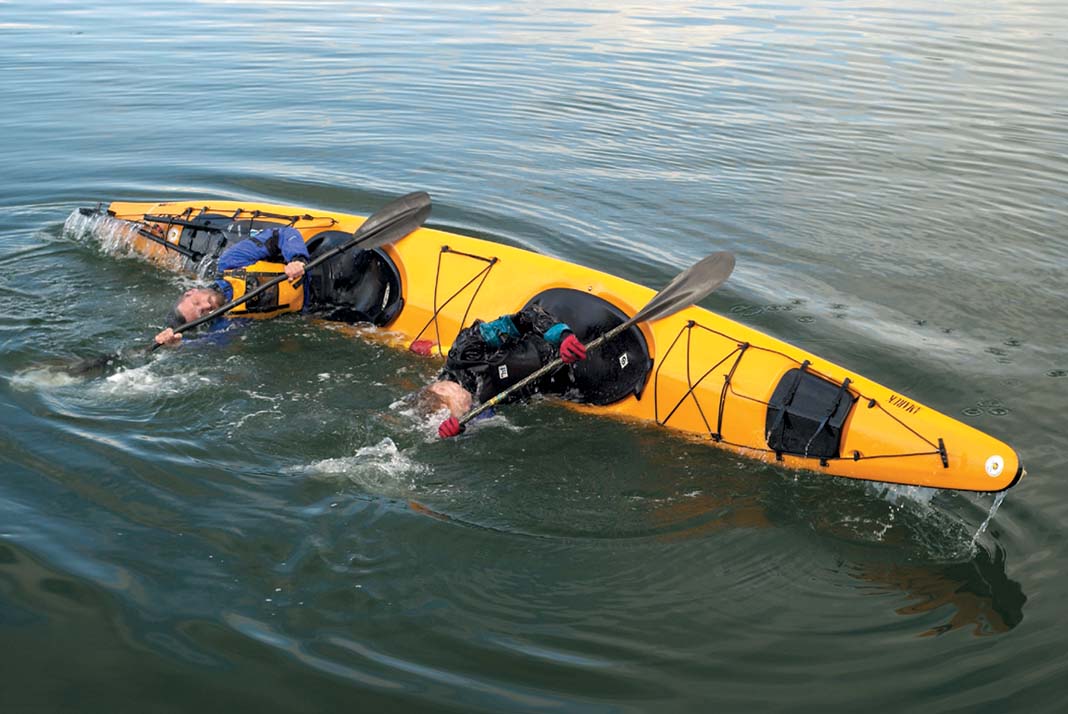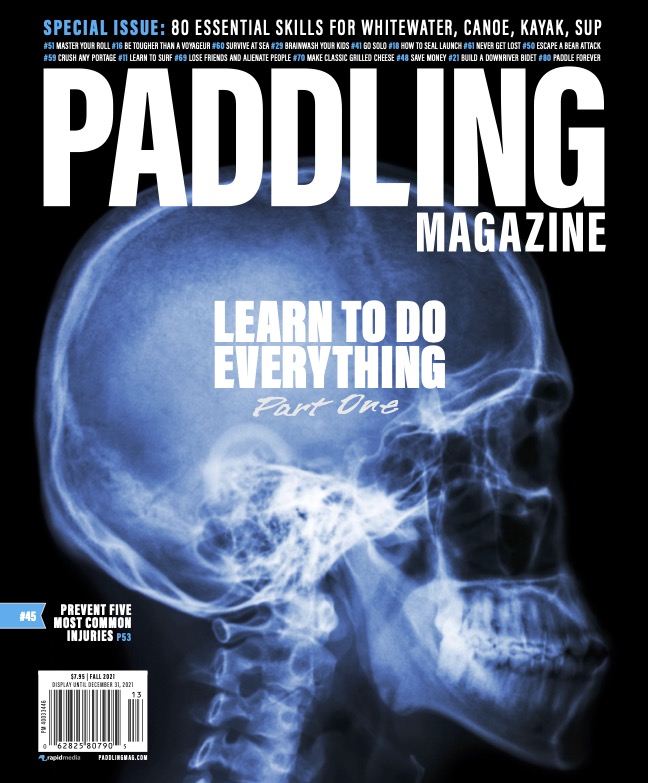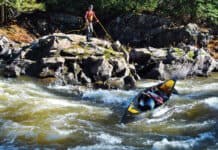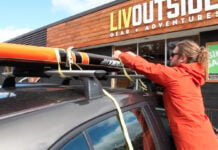In some quarters, tandem kayaking is synonymous with dull paddling and poor technique. But where is it written that tandems must be paddled conservatively? In any kayak, we should be safely pushing our limits to improve our skills. Double kayaks are no exception. We should be out there surfing in plastic doubles, doing huge seal launches, practicing lean turns and braces, sculling…and even nailing rolls. Try out these methods for a successful–and effortless–tandem kayak roll.
2 Techniques to Roll a Tandem Kayak
1 The tandem kayak roll
Tandem rolling is surprisingly easy. The mechanics are exactly the same as rolling a single kayak, except, of course, that you have to coordinate with a partner.
How to coordinate your roll
The key to success is to have both paddlers roll in unison. Before capsizing, agree which side you’re going to set up on. This seems obvious, but I’ve seen a very experienced team of a right-handed paddler and a leftie combine to almost lift a whole double free of the water—it sure didn’t roll!
Choose the strongest paddler as the lead. It then becomes the other partner’s job to set up for the roll and wait to feel the roll initiated. Some paddlers rely entirely on “feel” from the time of capsize. Or, the lead paddler can tap on the deck as a signal for setup, which will be followed by a predetermined count (a quick “one-chimpanzee, two-chimpanzee,” for instance) and then both paddlers start their rolls. When selecting a partner, high-grade toward musicians, dancers or synchronized swimmers. (The latter are used to holding their breath underwater and already come with their own nose plugs.)

How to execute the roll
No matter how you time it, the “following” paddler must feel for the progress of the lead roller, waiting for that little lift that signals the initial loading of the lead paddler’s blade. At that point, the following paddler jumps into their roll. It doesn’t matter what style of roll each paddler chooses, C-to-C or sweep, as long as at least one of the paddlers has a really strong roll. Try different rolls and see what works for your team.
Obviously all the usual rolling rules apply—reach for the surface, keep your heads down and drive the knees for a good hip snap. Without that hip snap you are never coming up. And if one paddler is pulling their head up too early, straining to get upright and leading with the noggin, it’s gonna be wet for both boaters.
All the little “cheats” apply too, and maybe even more so. If you find yourselves almost up, but not quite, keep those heads down and a quick scull will almost always get you the rest of the way upright. With two paddlers, you have a lot of lift on tap, but only if you can work together cooperatively. If you have the timing down, have strong solo rolls, and are both starting your rolls at the same time—and on the same side!—you are almost guaranteed success.
Using the tandem roll to teach a new paddler
The tandem roll is also a fun teaching tool. With a strong roller in the boat, the newer paddler can go through the rolling motions, getting the feel of the hip snap, over and over again without the usual hassle of a wet exit after every failed attempt. If the bow person is very inexperienced, it is far easier to have them simply hug the deck while the stern paddler rolls the tandem alone. If this sounds overly macho, try it. You’ll be surprised how easy it is.
2 The assisted reenter and roll
If you do blow your roll, the “reenter and roll” is an alternative self-rescue that works really well with a double. Why? Because you have an extra set of hands and a great big talking paddle float! After a capsize and wet exit, have the stern paddler reenter and roll the boat as the bow paddler, still in the water, helps out by simply grabbing the bow cockpit rim and flipping the boat in sync with the roll, or by acting as a great big paddle float.
With the stern paddler ready in the overturned tandem, the bow paddler moves in behind their partner, guides the sweeping paddle onto their shoulder and holds it at the surface. The bow paddler wearing a PFD represents a lot of flotation—the stern paddler now has an almost guaranteed roll.
The stern paddler, now happily upright in the boat, stabilizes as the bow partner scrambles aboard. As inelegant as this tandem self-rescue may seem, it is fast and effective with a well-practiced team, and eliminates fumbling around with a standard paddle float.
Need some motivation to learn the roll?
At least once (if not always), practice pumping out the fully swamped double. In many rescue practices, people fail to actually fully empty their kayak with a pump. It is a daunting task, and enough to inspire you to start working on a tandem roll.
Once you get comfortable doing rescues and rolls in a tandem, you’ll also be putting the boat on edge for lean turns, sprinting to catch wind waves, seeking out currents to play in and generally having more fun than you ever thought possible in a double sea kayak. You’ll be paddling just as playfully as you would paddle solo and enjoying the double’s extra power and speed.
You may even be more daring, what with a partner in crime right there in the same boat to egg you on. Even if you do happen to wet exit, you have two people working together to get yourselves back in the boat and ready for more. After all, two heads are better than one!
This article originally appeared in Paddling Magazine Issue 65. Subscribe to Paddling Magazine’s print and digital editions here, or download the Paddling Magazine app and browse the digital archives here.
Don’t get into double trouble! Follow these techniques for an effortless tandem kayak roll. | Feature photo: Josh McCulloch









You overlooked one of the simplest techniques which requires no synchronization—one paddler leans tightly onto the deck while other executes the roll. Two of us tested this method more than 25 years ago on the shores of Lake Michigan and it worked readily. We even tried it once in a Trisiutl—a 3 cockpit large kayak and it was no problem. My wife and I paddle tandems frequently now that she is in her late 70s and I am 85. Our strategy is for her to lean over kayak’s front cockpit while I roll us up. We have practiced it, but never have had to use it. I’m almost disappointed.